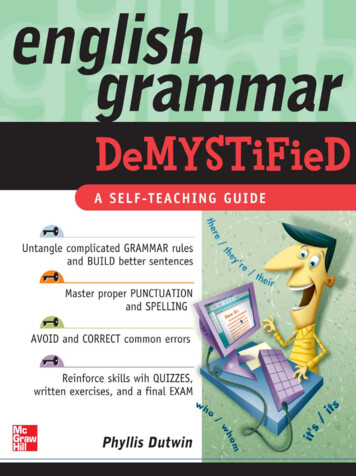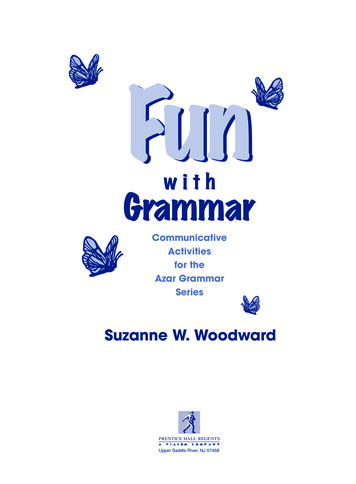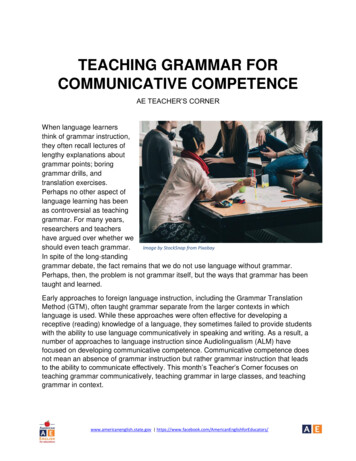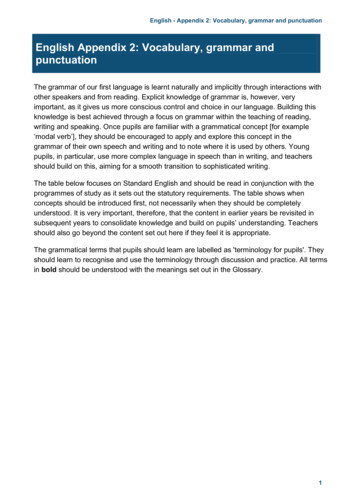
Transcription
englishgrammarDeMYSTiFieD
Demystified SeriesAccounting DemystifiedAdvanced Calculus DemystifiedAdvanced Physics DemystifiedAdvanced Statistics DemystifiedAlgebra DemystifiedAlternative Energy DemystifiedAnatomy DemystifiedAstronomy DemystifiedAudio DemystifiedBiochemistry DemystifiedBiology DemystifiedBiotechnology DemystifiedBusiness Calculus DemystifiedBusiness Math DemystifiedBusiness Statistics DemystifiedC DemystifiedCalculus DemystifiedChemistry DemystifiedCircuit Analysis DemystifiedCollege Algebra DemystifiedCorporate Finance DemystifiedDatabases DemystifiedDiabetes DemystifiedDifferential Equations DemystifiedDigital Electronics DemystifiedEarth Science DemystifiedElectricity DemystifiedElectronics DemystifiedEngineering Statistics DemystifiedEnvironmental Science DemystifiedEveryday Math DemystifiedFertility DemystifiedFinancial Planning DemystifiedForensics DemystifiedFrench DemystifiedGenetics DemystifiedGeometry DemystifiedGerman DemystifiedGlobal Warming and Climate ChangeDemystifiedHedge Funds DemystifiedInvesting DemystifiedItalian DemystifiedJapanese DemystifiedJava DemystifiedJavaScript DemystifiedLatin DemystifiedLean Six Sigma DemystifiedLinear Algebra DemystifiedMacroeconomics DemystifiedManagement Accounting DemystifiedMath Proofs DemystifiedMath Word Problems DemystifiedMATLAB DemystifiedMedical Billing and Coding DemystifiedMedical-Surgical Nursing DemystifiedMedical Terminology DemystifiedMeteorology DemystifiedMicrobiology DemystifiedMicroeconomics DemystifiedNanotechnology DemystifiedNurse Management DemystifiedOOP DemystifiedOptions DemystifiedOrganic Chemistry DemystifiedPharmacology DemystifiedPhysics DemystifiedPhysiology DemystifiedPre-Algebra DemystifiedPrecalculus DemystifiedProbability DemystifiedProject Management DemystifiedPsychology DemystifiedQuantum Field Theory DemystifiedQuantum Mechanics DemystifiedReal Estate Math DemystifiedRelativity DemystifiedRobotics DemystifiedSales Management DemystifiedSignals and Systems DemystifiedSix Sigma DemystifiedSpanish Demystifiedsql DemystifiedStatics and Dynamics DemystifiedStatistics DemystifiedTechnical Analysis DemystifiedTechnical Math DemystifiedTrigonometry DemystifiedVitamins and Minerals Demystified
englishgrammarDeMYSTiFieDPhyllis DutwinNew York Chicago San Francisco Lisbon London Madrid Mexico CityMilan New Delhi San Juan Seoul Singapore Sydney Toronto
Copyright 2010 by The McGraw-Hill Companies, Inc. All rights reserved. Except as permitted under the United States CopyrightAct of 1976, no part of this publication may be reproduced or distributed in any form or by any means, or stored in a database orretrieval system, without the prior written permission of the publisher.ISBN: 978-0-07-160081-1MHID: 0-07-160081-7The material in this eBook also appears in the print version of this title: ISBN: 978-0-07-160080-4, MHID: 0-07-160080-9.All trademarks are trademarks of their respective owners. Rather than put a trademark symbol after every occurrence of atrademarked name, we use names in an editorial fashion only, and to the benefit of the trademark owner, with no intention ofinfringement of the trademark. Where such designations appear in this book, they have been printed with initial caps.McGraw-Hill eBooks are available at special quantity discounts to use as premiums and sales promotions, or for use in corporatetraining programs. To contact a representative please e-mail us at bulksales@mcgraw-hill.com.TERMS OF USEThis is a copyrighted work and The McGraw-Hill Companies, Inc. (“McGraw-Hill”) and its licensors reserve all rights in and to thework. Use of this work is subject to these terms. Except as permitted under the Copyright Act of 1976 and the right to store andretrieve one copy of the work, you may not decompile, disassemble, reverse engineer, reproduce, modify, create derivative worksbased upon, transmit, distribute, disseminate, sell, publish or sublicense the work or any part of it without McGraw-Hill’s priorconsent. You may use the work for your own noncommercial and personal use; any other use of the work is strictly prohibited. Yourright to use the work may be terminated if you fail to comply with these terms.THE WORK IS PROVIDED “AS IS.” McGRAW-HILL AND ITS LICENSORS MAKE NO GUARANTEES OR WARRANTIESAS TO THE ACCURACY, ADEQUACY OR COMPLETENESS OF OR RESULTS TO BE OBTAINED FROM USING THEWORK, INCLUDING ANY INFORMATION THAT CAN BE ACCESSED THROUGH THE WORK VIA HYPERLINK OR OTHERWISE, AND EXPRESSLY DISCLAIM ANY WARRANTY, EXPRESS OR IMPLIED, INCLUDING BUT NOT LIMITED TOIMPLIED WARRANTIES OF MERCHANTABILITY OR FITNESS FOR A PARTICULAR PURPOSE. McGraw-Hill and itslicensors do not warrant or guarantee that the functions contained in the work will meet your requirements or that its operation willbe uninterrupted or error free. Neither McGraw-Hill nor its licensors shall be liable to you or anyone else for any inaccuracy, erroror omission, regardless of cause, in the work or for any damages resulting therefrom. McGraw-Hill has no responsibility for thecontent of any information accessed through the work. Under no circumstances shall McGraw-Hill and/or its licensors be liable forany indirect, incidental, special, punitive, consequential or similar damages that result from the use of or inability to use the work,even if any of them has been advised of the possibility of such damages. This limitation of liability shall apply to any claim or causewhatsoever whether such claim or cause arises in contract, tort or otherwise.
CONTENTSIntroductionixPART ONEALL ABOUT THE ENGLISH SENTENCECHAPTER 1The Essential Elements of the English SentenceSubject and VerbSentence Fragments and Run-OnsTime and Number: Agreement Between Subjectand VerbPerfect Verb TensesIrregular Verbs121819Introduction to the Parts of SpeechParts of 44464848CHAPTER 2345v
viContentsCHAPTER 3More About Verbs, Prepositions, and PronounsPerfect TensesPrepositional PhrasesMore About PronounsPersonal PronounsOwnership PronounsMirror PronounsRelative PronounsWho, Whom, That, or Which?Demonstrative PronounsIndefinite PronounsPART ONE TEST515257616164656768707177PART TWOALL ABOUT PUNCTUATIONAND CAPITALIZATIONCHAPTER 4Punctuation: End Marks and CommasBrief History of PunctuationPeriodQuestion MarkExclamation PointCommaCHAPTER 5More About PunctuationSemicolonQuotation MarksColonApostropheDash and HyphenParentheses and Brackets103104111114118120123CHAPTER 6CapitalizationBrief History of the Alphabet and CapitalizationModern Rules of CapitalizationPART TWO TEST127127129137898991939597
viiContentsPART THREEMASTERING GOOD SENTENCE STRUCTURECHAPTER 7Building Better SentencesBuilding Balanced SentencesCreating Well-Connected SentencesTrimming Unnecessary Words fromSentences153153160CHAPTER 8Punctuation Builds SentencesPunctuation in Sentence BuildingSimple SentencesCompound SentencesComplex SentencesCompound-Complex Sentences171171172174179183CHAPTER 9Style and ClarityWriting Clearer SentencesUsing Active VerbsPlacing Important Information LastUsing Verbs Instead of NounsAvoiding Unclear Pronoun ReferencesPlacing Descriptive Words CorrectlyDeleting Unnecessary WordsCorrecting Illogical StatementsWriting Balanced Sentences—a ReminderUsing Prepositions Correctly in a SeriesPART THREE TEST187188188191193195198200204206207213PART FOURSPELLING AND WORDUSAGE SKILLSCHAPTER 10Proven Techniques to Improve SpellingWho Needs Help with Spelling?Techniques for Improving Spelling SkillsHelpful Spelling Rules—or NotBecoming a Better Speller167229229231233241
viiiContentsCorrect Word UsageEasily Confused Words: Homonyms, Homophones,and HomographsIncorrectly Used Words and PhrasesWords That Sound Almost Alike but HaveDifferent MeaningsPART FOUR TEST243FINAL EXAM271APPENDIX AMost Commonly Misspelled Words295APPENDIX BThe 50 Most Deadly Common ErrorsAnswer Key303311Index335CHAPTER 11243257261265
INTRODUCTIONWhy should you study English? Do you speak and write English? That’s reasonenough. When you speak or write, you present yourself to others, and if you care atall about how you’re perceived—and who doesn’t?—you care about how your useof language represents you. Certainly, not all jobs depend exclusively upon writingand speaking skills, but most do to some significant extent. If you are in school,your teachers have probably set a standard for written and spoken English.As you begin English Grammar Demystified, get ready for a different learningexperience. English Grammar Demystified will help you better understand and usethe English language, but you will find that this book takes a different approachfrom the usual English improvement text. In the first two parts of this book, you willlearn the basics of English grammar with a thorough overview of the parts of speechand punctuation and capitalization rules. The third part of the book builds on theseskills, giving you sound advice on mastering proper sentence structure and refiningyour writing. The fourth part covers important spelling and word usage skills.In support of all of these concepts, you will also find great emphasis on findingcommon errors. In other words, this is not simply a grammar book. Rather, thisbook identifies where errors are most commonly made—so you can avoid them.You may, for example, know the definition of a pronoun (i.e., a word that takes theplace of a noun), but you may not recognize one of the most common pronounerrors. Read the following sentence:Incorrect: Me and Tom work in the same office.You know that me is a pronoun. It takes the place of someone’s name, so you conclude that it should be used as half of the subject of the sentence. Why is it incorrectin this context? In Chapters 2 and 3, you will learn why it is incorrect, but beyondix
xIntroductionthat, you will read many examples of this common error and have an opportunity tocorrect them.Correct: Tom and I work in the same office.How to Use This BookEach chapter is filled with Written Practice exercises that help reinforce the newgrammar concepts you learn. You are strongly encouraged to complete each exercise to help identify your strengths and weaknesses as you use this book. Check theAnswer Key to find out where any errors exist in your use of English.Each chapter ends with an open-book quiz with ten questions that review theconcepts introduced in the chapter. You should try to achieve a score of eight out often on a quiz before moving on to the next chapter. Each of the four parts ends witha test of fifty multiple-choice questions that review the content of that part. These areclosed-book tests, and you should try to get a score of 75 percent before moving onto the next part. The book concludes with a final exam with one hundred multiplechoice questions that test your knowledge of all the grammar and usage content ofthe book. A good score on this exam is 75 percent.The English Grammar Demystified chapters are meant to be studied consecutively. From the first chapter on, you will build your English language skills, oneupon the other. Don’t skip anything! The only chapters that may (and probablyshould) be studied on a different schedule are Chapters 10 and 11. Spelling andword usage are almost never-ending challenges for some people; consequently, anorganized, segmented approach works better. You simply can’t absorb all that thesechapters teach in one sitting. So make studying those chapters an ongoing activity.
PART ONEALL ABOUT THEENGLISH SENTENCE
This page intentionally left blank
CHAPTER 1The Essential Elementsof the EnglishSentenceIn this chapter you will learn:Subject and VerbSentence Fragments and Run-OnsTime and Number: Agreement Between Subject and VerbPerfect Verb TensesIrregular Verbs3
4English Grammar DemystifiedSubject and VerbAlthough it would not be very interesting, the simplest English sentence might becomposed of two words and still be correct:I voted.Tom drove.Trees fell.The point, of course, is that a complete English sentence is composed of a subject(I, Tom, Trees) and a verb, or action (voted, drove, fell).See if you can identify the subjects (person or thing) and verbs (actions) in thefollowing sentences:1. The senator won.2. Tom crashed the car.3. His wife screamed.4. Arctic air froze New England.5. We huddled together.You probably chose the following: senator/won, Tom/crashed, wife/screamed, air/froze, We/huddled. In each case, someone or something performed an action.Now read the following examples, and as you do, ask yourself what’s missing:what else do you need to know to get real meaning from the incompletesentence?1. A wandering child.2. Driving too slowly and stopping frequently.3. Stormy, then clear.Undoubtedly, in the first example, you wanted to know what happened to the child.What did he or she do? In the second example, who was driving and stopping? Inthe third example, what was stormy, then clear? Clearly, something is missing ineach example. You weren’t satisfied when you read the examples because they are
CHAPTER 1Elements of the English Sentence5all incomplete thoughts missing essential elements: subject (i.e., person, place, orthing) or a verb (i.e., the action). Because of the missing pieces, this kind of incomplete sentence is called a fragment—a piece of a thought.The following examples include possible completions for the previous fragments.Notice that either a subject or verb was added to each one:1. A wandering child ran into the street. (The verb ran answers the question,“What did the child do?”)2. The new driver was driving too slowly and stopping too frequently. (Thesubject, driver, answers the question, “Who was driving?”)3. The skies changed from stormy to clear. (The subject, skies, answers thequestion, “What changed from stormy to clear?)Sentence Fragments and Run-OnsYou just read examples of incomplete sentences (e.g., A wandering child). Becausethe examples represent only parts of complete thoughts, they’re called fragments. If,on the other hand, you were to string together sentence after sentence—with noperiods or semicolons in sight—you would be committing another type of errorcalled a run-on sentence. You’ll learn about both fragments and run-on sentences inthe following sections.SENTENCE FRAGMENTSFragments sometimes result when writers start sentences with words such as when,after, because, since, before, and as soon as. For example, does the following groupof words have a subject and a verb? Is it a complete sentence?When the new product arrives.The example has a subjectlike word, product, and a verblike word, arrives, and it isstill not a complete sentence. If you say it out loud, you will hear that it isunfinished:When the new product arrives . . .
6English Grammar DemystifiedThen what will happen? Possible completions include the following:When the new product arrives, we’ll call our advertisers.When the new product arrives, we’ll send a special introductory offer to ourbest customers.When the new product arrives, we’ll have to stay late to pack it for shipping.Groups of words may seem to be sentences because they contain subject and verbtype words, but beware of incomplete thoughts! In the initial example (When thenew product arrives.), product seems to be the subject and arrives seems to be theverb, yet the example is still an incomplete thought.As you read the following examples, decide if each has the subject and verb itneeds:1. Looking at the job market from a new perspective. (Hint: Beware ofsentences that start with -ing ending words.)2. My friend who teaches a wellness course.3. Heading for the West Coast for a five-day vacation.4. Your doctor’s appointment scheduled for Tuesday.5. When the man waiting to see you.Let’s take a look at what’s missing. In the first example, who is looking at the jobmarket? The subject is missing. The second example is tricky. My friend is the subject. The words who teaches a wellness course describe the friend. Still there is noverb. What does your friend do? Try this: My friend who teaches a wellness coursedrives 100 miles a day to get to her class. The verb is drives. In the third example,who was heading for the West Coast? The subject is missing. In the fourth example,the verb is missing. The fifth example needs an action to complete it.Written Practice 1-1Finish the following statements to make them complete sentences. There areseveral possible ways to complete the sentences; just be sure that each sentencehas a subject and verb.1. Before I leave for California.2. As soon as the rain stops.
CHAPTER 1Elements of the English Sentence73. Because I’m trying to get a promotion.4. When I exercise several times a week.5. After I took a nutrition course.6. As soon as the rain stops and we have all the information we needabout the weather7. Before I started this job and when I was looking for one.8. Since you started working here and agreed to take the early shift.9. After they serve lunch and we’ve stayed a while.10. Tom, whom everyone admires since he was precinct captain.SENTENCE FRAGMENTS IN INFORMAL ENGLISHWhen we’re writing or speaking informally to friends and relatives, we do use fragments, and that’s all right. However, the important word in the previous sentence isinformally. Obviously, you need to know the difference between formal and informal occasions.Informal: You say to your son, “Need money?” He says, “Sure.” You both understand very well what those fragments mean.In the workplace, informal English doesn’t always work, especially in writtencommunications. Look at this memo:MEMOFrom: ClaireTo:GinoRe:Office SuppliesGot enough supplies?In this case, there have to be many questions in the reader’s mind. What supplies isClaire asking about? For what period of time is Claire inquiring—this quarter, nextmonth, this afternoon? Better:
8English Grammar DemystifiedMEMOFrom:ClaireTo:GinoSubject: Office SuppliesWe are ordering tomorrow for the third quarter. What office supplies willyou need? Please include all paper goods as well as computer supplies andprinter ink. Please e-mail me or place your order on my desk by 4 P.M.Thanks,ClaireRUN-ON SENTENCESIf fragments are pieces of sentences, run-ons are too many pieces running together.Have you ever seen or written a sentence such as the following?Our new boss gave us his list of procedures some were already in our schedule.Run-on sentences are very confusing to read since you don’t know where one finishes and another starts. The two thoughts in this sentence could each stand alone:Our new boss gave us his list of procedures. Some were already in ourschedule.Or since the thoughts are closely connected, they could be combined using a punctuation mark as shown in the following examples. (You’ll learn much more aboutthis in Chapter 4 and Chapter 5.)Our new boss gave us his list of procedures; some were already in our schedule.Our new boss gave us a list of procedures, but some were already in ourschedule.Another kind of sentence error is called a “comma fault” because sentences arestrung together with the use of commas. For example:
CHAPTER 1Elements of the English Sentence9We had to register we did, then we stood in line for an hour, then the line didn’tmove, we went home.Note that removing the commas does not correct the problem, but results in a run-onsentence. You can, however, choose one of the following actions to correct thesentence:1. Write separate sentences.2. Change one or more commas to semicolons.3. Insert a coordinating conjunction such as and or but following the comma.4. Make one clause dependent upon the other.All of these options will come into play in later chapters on building sentencesand on punctuation.Written Practice 1-2Correct the following sentences.1. My hours will be 9 A.M. to 5 P.M. yours will be 8 A.M. to 4 P.M.2. Driving 230 difficult miles to our children’s home is exhausting we reallyprefer to fly there.3. We dread the Parkway portion of the trip, it’s busy even during off-hours.4. A medical myth states that we use only 10 percent of our brain, studiesusing imaging show that no part of the brain is completely inactive, don’tbelieve everything you read or hear.5. Larry says he’ll be right on time tomorrow I’ll believe it when I see it.6. When you’ve finished unpacking.
10English Grammar Demystified7. Being a first-time homeowner and living on a very tight budget.8. The menacing figure walking swiftly through the park.9. The community organized a march for food donations many people joinedthe march as it progressed we were too tired to do that.10. I didn’t buy enough yarn for my new knitting project, I turned around andwent right back to the store.FRAGMENTS AND RUN-ON SENTENCES IN E-MAILWhen should you be concerned about fragments and run-on sentences? Always.No matter what form of communication you use, be particularly careful to avoidthe errors you found in the preceding practices. The level of formality in your writing will not always be the same. You know with whom you can be casual and whorequires a more formal tone. Yet a caution regarding fragments and run-on sentences is always in order. This caution is particularly true when you use e-mail tocommunicate.Written communication is no longer limited to letters. We now enjoy instantcommunication through e-mail. This development is a good thing: it speeds yourmessage along and it can be more casual. Beware! Those positive aspects ofe-mailing can also function to sabotage you. How is that possible? The answer, ofcourse, is that whether you write a letter, a memo, a fax, or a report, if your nameis on it, you will be judged for the content. Consequently, you should know that allthe concepts in this chapter, and in this book, apply to e-mail as well.If you send the following e-mail to your best friend, no one will comment onyour omissions, fragments, and punctuation errors.From:Holly KimballTo:Liz WoodsSubject:
CHAPTER 1Elements of the English Sentence11Liz—Lunch? what time?H.If, however, you send the following to a business contact, you risk changing thatperson’s opinion of you. Again, don’t forget that your name is on the e-mail. If theperson who receives the e-mail stores all communications as a record, your e-mailbecomes a plastic bottle: you write it in five minutes, but it’s stored in the e-mailenvironment forever.From:Joe HidalgoTo:Harry MalcolmSubject:Harry you and i talked about instaling an air conditioning system in yourplant are you ready to go ahead with it can you call me tommorow at 11AM toplan the projectJoeHow can you improve this e-mail? Start from the top. The subject line is blank.Should Harry, a very busy man, have to read through the entire e-mail to determinethe subject? What specific subject would you include?Now look back at the body of the e-mail. Find the run-on sentence errors. Howwould you correct them? In the following example, you’ll see one way of correctingthe errors. Notice that spelling errors have been corrected as well. (Why didn’t Joeat least use the spell-checker on his computer?)From:Joe HidalgoTo:Harry MalcolmSubject: Date for installation of air-conditionerYou and I talked about installing an air-conditioning system in your plant.Are you ready to go ahead with it? Can you call me tomorrow at 11 A.M. toplan the project?
12English Grammar DemystifiedTime and Number: Agreement Between Subjectand VerbIn any list of common errors in English, lack of agreement between subject and verbranks high. For example:The berries in my cereal tastes so sweet.To correct an agreement error, you need to identify both the subject and the verb.Whenever possible, start by identifying the verb. In the example sentence, the verbis tastes. Then you can ask, what tastes? The berries tastes. Oops! You just foundthe error. Berries is a plural subject and the verb must agree with it. Decide whichis correct:Berries tastes.Berries taste.Of course it is the latter. Later in this chapter, you will have an opportunity to learnmore about this important concept.In addition, just ahead, you will discover how the times (tenses) of verbs must beconsistent and logical as verbs follow one another. What’s wrong with thefollowing?Yesterday, I reprimanded the children when they run into the street.Obviously, yesterday and reprimanded indicate past time, but run is in the presenttime. Change run to the past time—ran:Yesterday, I reprimanded the children when they ran into the street.Written Practice 1-3In the following paragraphs, check the tenses of all the verbs for consistency oftime. Find the one verb in each paragraph that needs to be corrected.Paragraph 1Children are not always happy to play alone. Does that mean that parents have todevote all their time to playing with their children? No, it didn’t. Certain techniqueswork to encourage children to play on their own.
CHAPTER 1Elements of the English Sentence13Paragraph 2In 1999, The Academy of Pediatrics provided some guidelines for children and TV.They suggest that children under two years old should not watch TV. They advisedthat even older children should not watch TV before bedtime. Instead, they said thatparents should read to children, or children might read to themselves and with theirparents.Written Practice 1-4In each of the following sentences, find the verb (action word). Label each verbpresent, past, or future. The first one is done for you.1. A consumer quickly learns that “living green” is not easy. learns/present2. I will avoid plastic packaging as much as possible.3. My family turned off the lights all over the house.4. Toby decided to cycle to work.5. Marilyn’s child uses much less hand towels than my child does.6. He eats lunch at the same time every day.7. Our three children will play together tomorrow.8. They ate lunch in the park.9. I collected shells on the beach.10. I keep a scrapbook for each child.11. You will ask yourself some important questions before the election.12. The law student completed his final exam.13. David played the guitar in the band Neville Blues.14. Aidan will start school next year.15. The car stops at every yellow light.CONSISTENT VERB TENSE IN PARAGRAPHSThe verb tenses in the previous written practice section were likely easy to determine. You have just made decisions about tense in single sentences, and you can do
14English Grammar Demystifiedthis for verbs in paragraphs, too. There is one additional consideration: That is, isthe tense consistent throughout the paragraph? Read the following paragraph, anddecide if the writer was consistent.When I decide to ask for a raise at work, I do some homework first. First,I consult the Occupational Outlook Handbook from the U.S. Departmentof Labor to check recent salaries in my field. Then I gather my recentperformance evaluations, and I reread them carefully to recall the list of myaccomplishments. However, I still need to list accomplishments that haveaccrued since that evaluation. I always list higher sales, the number of salescalls, and the number of those calls that result in sales.You probably realized that the writer was consistent in this paragraph. Some of thepresent tense verbs are decide, do, consult, gather, reread, and need. Now read thisparagraph with the same task in mind. Is the tense consistent?Your company may not be in a position to offer you a raise. If the companywas laying people off, it is probably not a good idea to ask for a raise at thistime. Asking for a substantial raise can only make you seem unrealistic anduntouched by what is going on around you. Instead, ask for something otherthan money, such as flex time, or a better office, or new equipment.Here are some verbs: offer, was laying off, ask. Are they all in the same tense?Clearly, the writer meant to write in the present tense, but one verb does not conform: was laying off indicates the past; it should be is laying off.Written Practice 1-5In the following paragraph, choose the correct verb for each sentence. The firstone (opens) is provided for you and sets the tense, or time, in the present.Every morning Maria opens the office and immediately (checks/checked)the fax machine for messages. It seems that each day more and moreunsolicited faxes (will appear/appear). Now Maria (knows/knew) she willhave to find a way to unlist the fax number.SUBJECT AND VERB AGREEMENT IN NUMBERAs you read in the introduction to this section, a verb changes depending on whetherthe subject of the sentence is singular or plural. Look at the following examples:
CHAPTER 1Elements of the English Sentence15The new computer saves me so much time.The new computers save us so much time.In the first sentence, the subject is computer and it is singular—there is only one. Inthe second sentence, the subject is computers and it is plural, meaning there is morethan one. A singular noun, such as one computer, does not have an s; but a pluralnoun, such as two or more computers, uses the s to show there is more than one.Now look at the verb. One computer saves me so much time. The verb takes an s toaccommodate a singular subject. Obviously, verbs don’t work according to the samerules as nouns. With a verb, an added s means that it is singular, not plural.One more complication: sometimes two words are used to form a pluralsubject:A desk and a chair (plural subject) stand (plural verb—no s) in the corner ofthe room. Two things stand in the room.A desk stands in the corner of the room. One thing stands in the room.Once again, a plural subject is followed by a verb with no s. A singular subject isfollowed by a verb with an s ending.Let’s look at more examples:Food and exercise (plural subject) comprise (plural verb—no s) an importantpart in any weight-loss program.The two candidates (plural subject) address (plural verb—no s) the crowd.My son and daughter (plural subject) live (plural verb—no s) on their own now.Two cars (plural subject) vie (plural verb—no s) for that spot each morning.Written Practice 1-6For each of the following sentences, see if there is agreement in num
As you begin English Grammar Demystifi ed, get ready for a different learning experience. English Grammar Demystifi ed will help you better understand and use the English language, but you will fi nd that this book takes a different approach from the usual English improv










